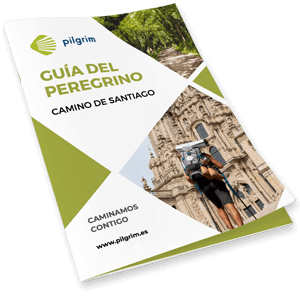Chantada
‹ Back to the stage
Chantada
- Residents: 8.553 aprox.
- Province: Lugo
Information
Get to know Chantada
Chantada besides being a village, gives its name to the region, which is also known as the heart of Galicia. It is very rich in heritage and history as well as in wine.
In this town the pilgrim will not lack anything, it has all the services that a walker may need.
<pLocation
How to get there
The main way to reach the municipality of Chantada is by road: the A-6 highway, which connects A Coruña and Madrid. At the Lugo exit you will find the N-540 that leads to Chantada. By the AP-53, which joins Santiago and Ourense; at the height of the latter you must take the N-540 towards Lugo until you reach Chantada. The same happens with the A-52, as you will have to leave it at the height of Ourense to continue on the N-540.
It is also possible to reach the town both by train and by bus, as there are several regular lines that operate daily from the main Galician cities.
History / Culture
What to see
Casa de Carral Travesa
The Casa de Carral Travesa is located in Carral Travesa, in the parish of Sabadelle as its name indicates. The construction is similar to many other houses of Chantada Fuertes, presenting only one floor, and the provisions are placed surrounding an inner courtyard.
Outstanding is a tall element that protrudes assimilating a tower. The architectural ensemble is completed with a dovecote and a simple chapel in which there is a beautiful altarpiece from the first third of the eighteenth century.

Casco Antiguo
The old town of Chantada preserves magnificent buildings and old mansions and is bounded between the Santa Ana square and the current Manuel Formoso Lamas street. This historical complex is the neuralgic point of the town. If we walk through its streets we can observe the daily life of the neighbors, working, shopping or just strolling.

Casona de Lemos
The Casona de Lemos is the oldest farmhouse in Chantada and still has the original structure of the fifteenth century, although the building dates from 1551. In other times it became a horse court that, little by little, grew as more ranches were annexed to it.
There are many stories around this house, there were some disputes and they became of such a level that even the Marquise of Astorga had to act as mediator with a letter-order.
The house has two beautiful wooden arcades with pilasters and has a good fireplace. The west wall is worth appreciating as it still retains the same stone 1668 laid by Pedro de Moure Ulloa, priest of the church of Chantada. Within the layouts of the house you can see a fairly modern and well-preserved building thanks to the work of the magnificent architect Manuel Gallego.
At present it is possible to visit its interior, since the town hall has enabled it for that use and also houses the House of Culture.
INFORMATION OF INTEREST
.E-mail:cultura@concellodechantada.orgTeléfono: 982 441 752

Castro Candaz
The Castro Candaz is half flooded by the waters of the Miño river due to the construction of the Belesar reservoir, so you have to wait for times of drought, when the flow level of the Miño lowers to see it.
The Castro Candaz is half flooded by the waters of the Miño river due to the construction of the Belesar reservoir, so you have to wait for times of drought, when the flow level of the Miño lowers to see it.
This magnificent settlement is one of the most striking, but it is located in an area of low visibility and too far from the rest of civilization, so you could say that it is ”locked” between the Miño and the river Enviande. Moreover, it can only be accessed from the west.
Curiously the castro defends itself thanks to three plateaus with which it avoided the arrival of possible enemies and looters. Now in these plateaus there are many vineyards and it is believed that they could have been used as courtyards where the warriors got in and the people defended the castro.

Fortaleza de Chantada
The Fortress of Chantada was a great construction in its time, but, in spite of this, it spent many years collapsed, until it was rebuilt in 1789. Its owner was the well-known Marquis of Astorga, Vicente Joaquín Osorio de Moscoso, who donated a virile to the church of Asma river. But after the collapse of the fortress it was gauged in the name of Jacobo Ignacio Guerra, who at that time was a well-known notary of Chantada.

Iglesia de San Salvador de Brigos
The Church of San Salvador de Brigos presents a Romanesque style but as it could not be otherwise there are some elements that were remodeled or rebuilt, such as the height of the south facade that was modified and the addition of a sacristy later so we will find small traces of other styles.
In the upper area of the frontispiece in an engraving appears the year 1228, when the church was inaugurated. Although almost all the details are currently preserved in good condition we find that the north entrance is walled up.
The highlight of the interior of the church is a beautiful statue of San Salvador.
The most remarkable thing about the interior of the church is a beautiful statue of San Salvador.

Iglesia de Santa María de Nogueira
The Church of Santa María de Nogueira, in Eirexe, was built during the second half of the 12th century and belonged to the old jurisdiction of Chantada. This temple curiously exercised the ecclesiastical benefit to three bodies, on the one hand to the priory of San Salvador de Asma, to the marquisate of Bendaña and to the bond of the House of Penachá.
<pOver the years the temple underwent several reforms, for example it should be said that the tower and facade are from the eighteenth century, although this has baroque elements and a late Romanesque rose window. This magnificent church has only one nave from which stands out the south door with an archivolt supported by pilasters.
It is noteworthy that on the south wall there are up to seven different lapidary representations, with some tombstones tucked between the walls of the church.

Sepulturas antropomorfas de Fornás
The Anthropomorphic Graves of Fornas are located in the parish of San Cristovo de Fornas, almost two kilometers from Asma. They can be seen from afar as they are located on top of a rock, very close to the road that goes from Chantada to Antas de Ulla.
When you get to the top you can appreciate a hollow in which there are two niches, it is said that one belonged to a man and the other to a woman, however, there are sources that confirm that the graves hosted the bodies of two druid priests.

Iglesia de San Cristóbal de Fornás
The Romanesque style Church of San Cristovo de Fornas dates back to the second half of the 12th century, corroborated by an engraving on the tympanum, although today it is not very well appreciated due to the wear and tear of time.
The church of San Cristovo de Fornas dates back to the second half of the 12th century.
It consists of a single nave with a curious rectangular apse and wooden gable roof and from the outside we can see a nice opening in the apse. Like many temples of that century, it underwent hundreds of rebuildings and modifications, but it is fortunate that both the nave and the apse remain Romanesque.
Magnificent 16th- to 17th-century paintings of the Resurrection were also discovered. The church is known as San Cristovo de Fornas as the paintings are said to have been done by the master of Fornas.

Information of interest
Local police
657 063 779
Civil guard
982 440 003
Fire department
982 454 119
Civil protection
982 889 338
Town hall
982 440 011
Health center
982 441 914
Tourism office
982 441 752
C/ Plaza del mercado, s/n

We send you your itinerary
Enter your details and receive your travel itinerary by email
Recommended
Gastronomy
Recommended
Festivals and Pilgrimages
Local festivity
Abril: Fiesta de la Sidra
Local festivity
11 al 13 de marzo: Feria del Vino
Local festivity
Última semana de Agosto: Fiestas patronales, la feria de la empanada y el Folión de Carros
Local festivity
18 de Octubre: Romería de San Luca
Local festivity
Los días 5 y 21 de cada mes: Feria del pueblo
Local festivity
15 de Agosto y el 8 de Septiembre: Fiestas en honor a Nuestra Señora del Faro
Winter Way
On foot
10 stages












